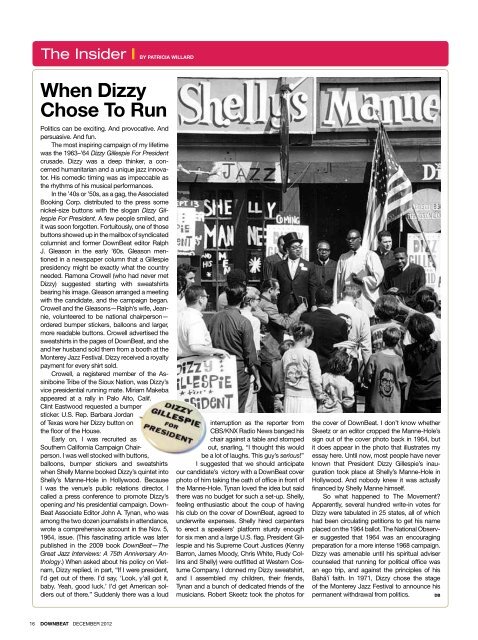Ron Carter Esperanza Spalding - Downbeat
Ron Carter Esperanza Spalding - Downbeat
Ron Carter Esperanza Spalding - Downbeat
Create successful ePaper yourself
Turn your PDF publications into a flip-book with our unique Google optimized e-Paper software.
The Insider | By patricia willard<br />
When Dizzy<br />
Chose To Run<br />
Politics can be exciting. And provocative. And<br />
persuasive. And fun.<br />
The most inspiring campaign of my lifetime<br />
was the 1963–’64 Dizzy Gillespie For President<br />
crusade. Dizzy was a deep thinker, a concerned<br />
humanitarian and a unique jazz innovator.<br />
His comedic timing was as impeccable as<br />
the rhythms of his musical performances.<br />
In the ’40s or ’50s, as a gag, the Associated<br />
Booking Corp. distributed to the press some<br />
nickel-size buttons with the slogan Dizzy Gillespie<br />
For President. A few people smiled, and<br />
it was soon forgotten. Fortuitously, one of those<br />
buttons showed up in the mailbox of syndicated<br />
columnist and former DownBeat editor Ralph<br />
J. Gleason in the early ’60s. Gleason mentioned<br />
in a newspaper column that a Gillespie<br />
presidency might be exactly what the country<br />
needed. Ramona Crowell (who had never met<br />
Dizzy) suggested starting with sweatshirts<br />
bearing his image. Gleason arranged a meeting<br />
with the candidate, and the campaign began.<br />
Crowell and the Gleasons—Ralph’s wife, Jeannie,<br />
volunteered to be national chairperson—<br />
ordered bumper stickers, balloons and larger,<br />
more readable buttons. Crowell advertised the<br />
sweatshirts in the pages of DownBeat, and she<br />
and her husband sold them from a booth at the<br />
Monterey Jazz Festival. Dizzy received a royalty<br />
payment for every shirt sold.<br />
Crowell, a registered member of the Assiniboine<br />
Tribe of the Sioux Nation, was Dizzy’s<br />
vice presidential running mate. Miriam Makeba<br />
appeared at a rally in Palo Alto, Calif.<br />
Clint Eastwood requested a bumper<br />
sticker. U.S. Rep. Barbara Jordan<br />
of Texas wore her Dizzy button on<br />
the floor of the House.<br />
Early on, I was recruited as<br />
Southern California Campaign Chairperson.<br />
I was well stocked with buttons,<br />
balloons, bumper stickers and sweatshirts<br />
when Shelly Manne booked Dizzy’s quintet into<br />
Shelly’s Manne-Hole in Hollywood. Because<br />
I was the venue’s public relations director, I<br />
called a press conference to promote Dizzy’s<br />
opening and his presidential campaign. Down-<br />
Beat Associate Editor John A. Tynan, who was<br />
among the two dozen journalists in attendance,<br />
wrote a comprehensive account in the Nov. 5,<br />
1964, issue. (This fascinating article was later<br />
published in the 2009 book DownBeat—The<br />
Great Jazz Interviews: A 75th Anniversary Anthology.)<br />
When asked about his policy on Vietnam,<br />
Dizzy replied, in part, “If I were president,<br />
I’d get out of there. I’d say, ‘Look, y’all got it,<br />
baby. Yeah, good luck.’ I’d get American soldiers<br />
out of there.” Suddenly there was a loud<br />
interruption as the reporter from<br />
CBS/KNX Radio News banged his<br />
chair against a table and stomped<br />
out, snarling, “I thought this would<br />
be a lot of laughs. This guy’s serious!”<br />
I suggested that we should anticipate<br />
our candidate’s victory with a DownBeat cover<br />
photo of him taking the oath of office in front of<br />
the Manne-Hole. Tynan loved the idea but said<br />
there was no budget for such a set-up. Shelly,<br />
feeling enthusiastic about the coup of having<br />
his club on the cover of DownBeat, agreed to<br />
underwrite expenses. Shelly hired carpenters<br />
to erect a speakers’ platform sturdy enough<br />
for six men and a large U.S. flag. President Gillespie<br />
and his Supreme Court Justices (Kenny<br />
Barron, James Moody, Chris White, Rudy Collins<br />
and Shelly) were outfitted at Western Costume<br />
Company. I donned my Dizzy sweatshirt,<br />
and I assembled my children, their friends,<br />
Tynan and a bunch of dedicated friends of the<br />
musicians. Robert Skeetz took the photos for<br />
the cover of DownBeat. I don’t know whether<br />
Skeetz or an editor cropped the Manne-Hole’s<br />
sign out of the cover photo back in 1964, but<br />
it does appear in the photo that illustrates my<br />
essay here. Until now, most people have never<br />
known that President Dizzy Gillespie’s inauguration<br />
took place at Shelly’s Manne-Hole in<br />
Hollywood. And nobody knew it was actually<br />
financed by Shelly Manne himself.<br />
So what happened to The Movement?<br />
Apparently, several hundred write-in votes for<br />
Dizzy were tabulated in 25 states, all of which<br />
had been circulating petitions to get his name<br />
placed on the 1964 ballot. The National Observer<br />
suggested that 1964 was an encouraging<br />
preparation for a more intense 1968 campaign.<br />
Dizzy was amenable until his spiritual adviser<br />
counseled that running for political office was<br />
an ego trip, and against the principles of his<br />
Bahá’í faith. In 1971, Dizzy chose the stage<br />
of the Monterey Jazz Festival to announce his<br />
permanent withdrawal from politics. DB<br />
16 DOWNBEAT DECEMBER 2012
















